ASUS NUC14RVHv7 and ASRock Industrial NUC BOX-155H Review: Meteor Lake Brings Accelerated AI to UCFF PCs
by Ganesh T S on May 23, 2024 8:00 AM EST- Posted in
- Systems
- Intel
- Asus
- NUC
- UCFF
- Mini-PC
- ASRock Industrial
- Meteor Lake
GPU Performance: Synthetic Benchmarks
The integrated GPU in Meteor Lake-H is a pared down version of the one used in Intel's discrete Arc GPUs. The Meteor Lake-H architecture isolates the media engine and display pipe away from the GPU tile. The new iGPU also includes ray-tracing support.
GPU performance evaluation typically involved gaming workloads, and for select PCs, GPU compute. Prior to that, a look at the capabilities of the GPUs in the two MTL-H systems being evaluated today.
The Intel Arc Graphics in the two systems is a completely new architecture for the mobile processor market. The two different systems have largely similar iGPU configurations, with the notable difference being that the one in the Revel Canyon NUC can operate at up to 50 MHz more. The performance of the Arc iGPU helps Intel regain parity with the new RDNA3-based iGPU in the latest AMD-based systems, as shown in the benchmarks below.
GFXBench
The DirectX 12-based GFXBench tests from Kishonti are cross-platform, and available all the way down to smartphones. As such, they are not very taxing for discrete GPUs and modern integrated GPUs. We processed the offscreen versions of the 'Aztec Ruins' benchmark.
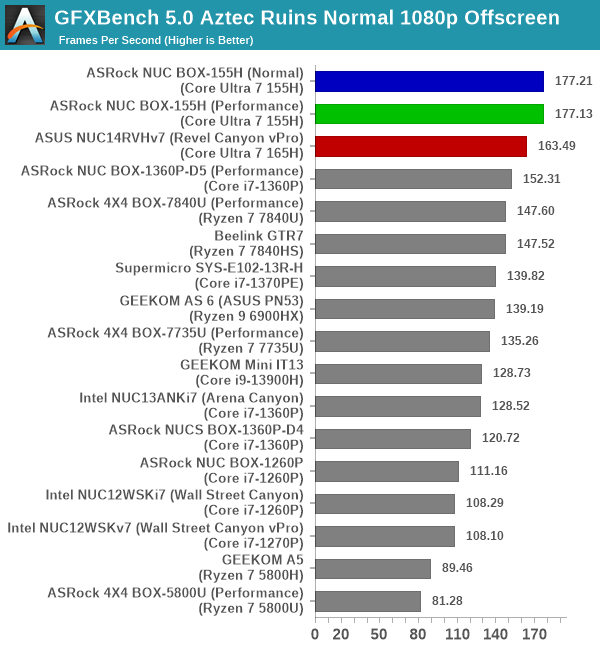

Interestingly, we see the configuration with the slightly lower GPU speeds in the NUC BOX-155H come out with better numbers compared to the Revel Canyon NUC with a faster clock. It is a trend we will observe right through this section, and is probably related to the power budget allocated to the iGPU.
UL 3DMark
Four different workload sets were processed in 3DMark - Fire Strike, Time Spy, Night Raid, and Wild Life.
3DMark Fire Strike
The Fire Strike benchmark has three workloads. The base version is meant for high-performance gaming PCs. It uses DirectX 11 (feature level 11) to render frames at 1920 x 1080. The Extreme version targets 1440p gaming requirements, while the Ultra version targets 4K gaming system, and renders at 3840 x 2160. The graph below presents the overall score for the Fire Strike Extreme and Fire Strike Ultra benchmark across all the systems that are being compared.
| UL 3DMark - Fire Strike Workloads | |||
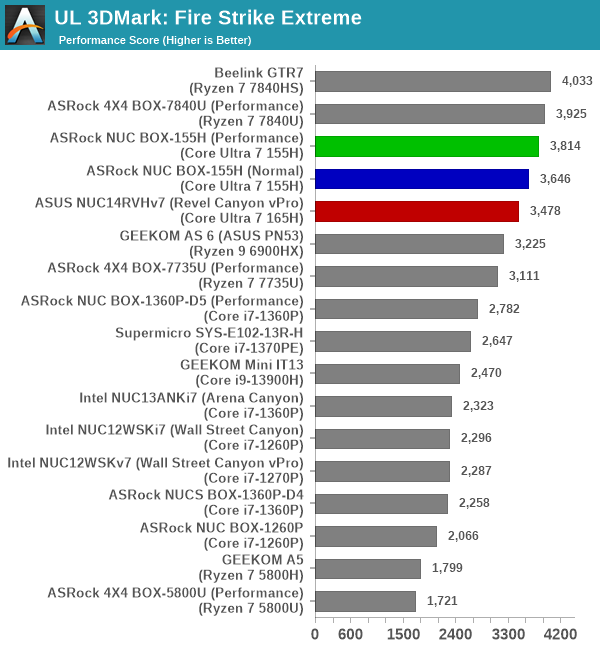
The RDNA3 iGPU in the Phoenix-based systems manages to come out on top in the two workloads, but the Meteor Lake-based systems are right behind, with the internal ordering the same as what was observed in the previous test. There is a significant uplift over the NUCs in the previous generations.
3DMark Time Spy
The Time Spy workload has two levels with different complexities. Both use DirectX 12 (feature level 11). However, the plain version targets high-performance gaming PCs with a 2560 x 1440 render resolution, while the Extreme version renders at 3840 x 2160 resolution. The graphs below present both numbers for all the systems that are being compared in this review.
| UL 3DMark - Time Spy Workloads | |||
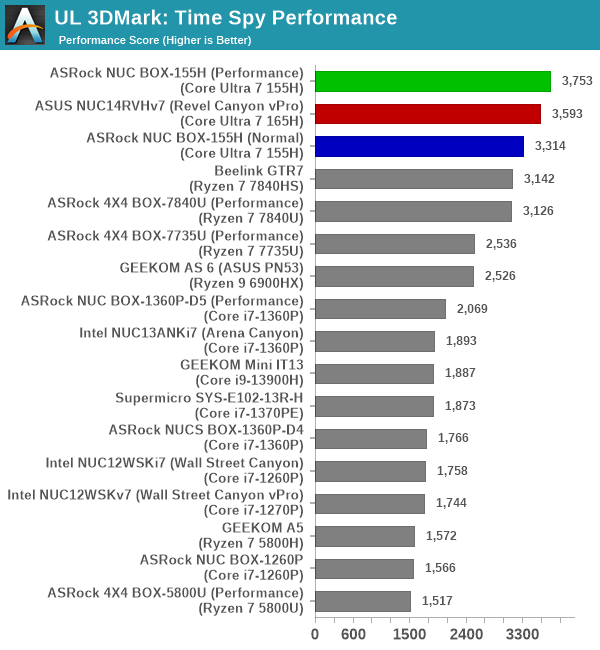
The Arc iGPU in Meteor Lake takes up the top three spots in both Time Spy configurations, as shown above. The two Phoenix-based systems take up the next two spots.
3DMark Wild Life
The Wild Life workload was initially introduced as a cross-platform GPU benchmark in 2020. It renders at a 2560 x 1440 resolution using Vulkan 1.1 APIs on Windows. It is a relatively short-running test, reflective of mobile GPU usage. In mid-2021, UL released the Wild Life Extreme workload that was a more demanding version that renders at 3840 x 2160 and runs for a much longer duration reflective of typical desktop gaming usage.
| UL 3DMark - Wild Life Workloads | |||
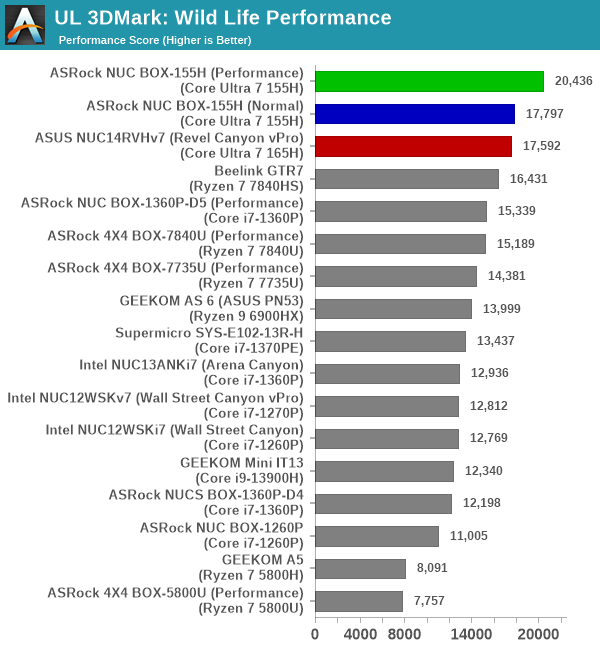
The 1440p version sees the Meteor Lake-based systems on top, but the 4K version sees a much closer fight. The two Phoenix-based systems take up the first and third spots, while the 40W NUC BOX-155H manages to sneak in between them.
3DMark Night Raid
The Night Raid workload is a DirectX 12 benchmark test. It is less demanding than Time Spy, and is optimized for integrated graphics. The graph below presents the overall score in this workload for different system configurations.

RDNA3 scores a win here, with the Phoenix-based systems taking up the top two spots and followed immediately by the three MTL-H configurations.
3DMark Port Royal
UL introduced the Port Royal ray-tracing benchmark as a DLC for 3DMark in early 2019. The scores serve as an indicator of how the system handles ray-tracing effects in real-time.
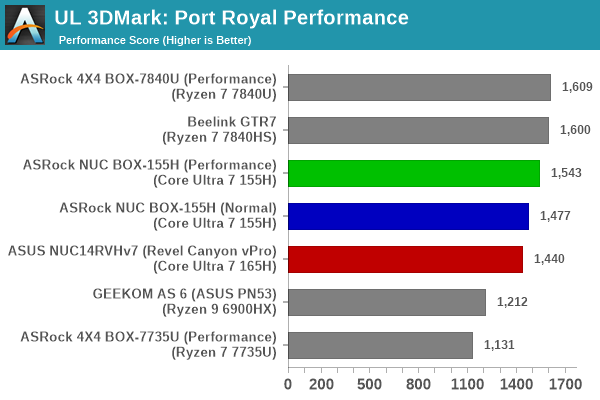
RDNA3's ray tracing performance is slightly better than that of MTL-H. The RDNA2 ray tracing in the Rembrandt SoC makes up the bottom half of the pack.



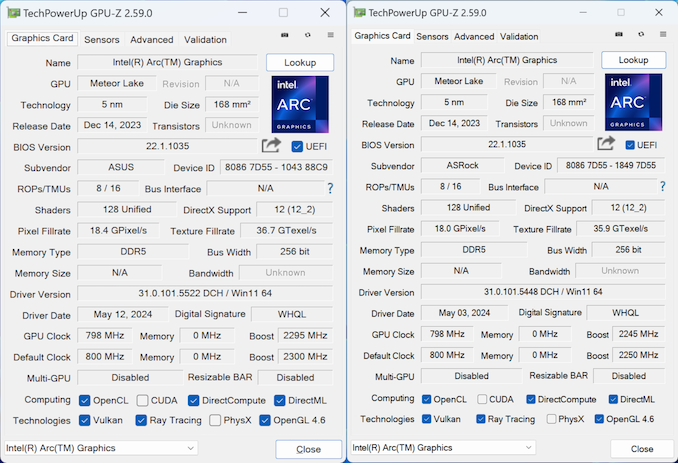








14 Comments
View All Comments
meacupla - Thursday, May 23, 2024 - link
I suspected it would work fine as a mini-PC.Asus' implementation hitting 100c under load is disappointing, but that's on Asus for not equipping it with adequate cooling.
shabby - Thursday, May 23, 2024 - link
Don't forget to blame intel for letting a mobile chip run at 115w.meacupla - Thursday, May 23, 2024 - link
With all the recent power limit and stability controversy, my money is on Asus being the worse offender. It's entirely up to the OEM if they want to use 115W or not.AsRock's implementation doesn't hit 100c.
shabby - Thursday, May 23, 2024 - link
Yes it does, keep reading further.TheinsanegamerN - Friday, May 24, 2024 - link
Intels reputation for being hot and slow continues unabated.James5mith - Thursday, May 23, 2024 - link
According to the color coding on the Jetstream graphs, Chrome/Edge were run on one of the NUCs, and Firefox on the other.You should probably try and keep those color codes consistent and matching what they are meant to match.
wr3zzz - Friday, May 24, 2024 - link
This is an example of there are no bad products, only bad prices.powerarmour - Sunday, May 26, 2024 - link
Oh there's definitely bad products too, like this.ionuts - Friday, May 24, 2024 - link
Why not use an USB-C PSU?TheinsanegamerN - Friday, May 24, 2024 - link
Because why would they when they have a ready supply of mini barrel power supplies?